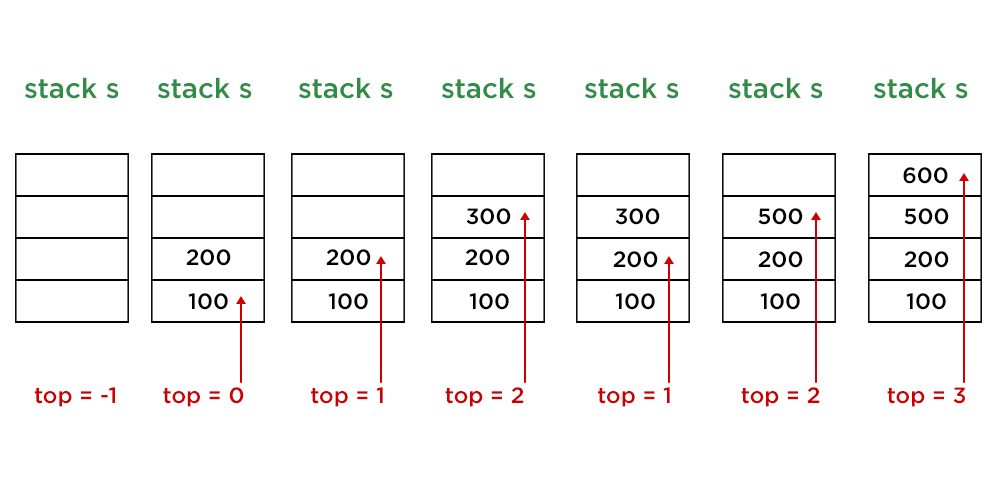Stack es una estructura de datos lineal que se basa en el concepto LIFO (last in first out). En lugar de solo una pila de enteros, la pila puede ser de tipo string, carácter o incluso flotante. Hay 4 operaciones principales en la pila de la siguiente manera:
- El método push() agrega el elemento x a la pila.
- El método pop() elimina el último elemento de la pila.
- El método top() devuelve el último elemento de la pila.
- El método empty() devuelve si la pila está vacía o no.
Nota: la complejidad del tiempo es de orden 1 para todas las operaciones de la pila
Ilustración:

Pila 1
let s = empty stack of Integer type with size 4
Pila 2
push (100) : top = top + 1 and s[top] = 100
Pila 3
push (200) : top = top + 1 and s[top] = 200
Pila 4
push (300) : top = top + 1 and s[top] = 300
Pila 5
pop ( ) : top = top - 1
Pila 6
push (500) : top = top + 1 and s[top] = 500
Pila 7
push (600) : top = top + 1 and s[top] = 600
Nota:
push (700) : top +1 == size of stack : Stack Overflow ! // Since top = 3 and size of stack = 4, no more elements can be pushed
Implementación:
Ejemplo
Java
// Java Program to Implement Stack in Java Using Array and
// Generics
// Importing input output classes
import java.io.*;
// Importing all utility classes
import java.util.*;
// user defined class for generic stack
class stack<T> {
// Empty array list
ArrayList<T> A;
// Default value of top variable when stack is empty
int top = -1;
// Variable to store size of array
int size;
// Constructor of this class
// To initialize stack
stack(int size)
{
// Storing the value of size into global variable
this.size = size;
// Creating array of Size = size
this.A = new ArrayList<T>(size);
}
// Method 1
// To push generic element into stack
void push(T X)
{
// Checking if array is full
if (top + 1 == size) {
// Display message when array is full
System.out.println("Stack Overflow");
}
else {
// Increment top to go to next position
top = top + 1;
// Over-writing existing element
if (A.size() > top)
A.set(top, X);
else
// Creating new element
A.add(X);
}
}
// Method 2
// To return topmost element of stack
T top()
{
// If stack is empty
if (top == -1) {
// Display message when there are no elements in
// the stack
System.out.println("Stack Underflow");
return null;
}
// else elements are present so
// return the topmost element
else
return A.get(top);
}
// Method 3
// To delete last element of stack
void pop()
{
// If stack is empty
if (top == -1) {
// Display message when there are no elements in
// the stack
System.out.println("Stack Underflow");
}
else
// Delete the last element
// by decrementing the top
top--;
}
// Method 4
// To check if stack is empty or not
boolean empty() { return top == -1; }
// Method 5
// To print the stack
// @Override
public String toString()
{
String Ans = "";
for (int i = 0; i < top; i++) {
Ans += String.valueOf(A.get(i)) + "->";
}
Ans += String.valueOf(A.get(top));
return Ans;
}
}
// Main Class
public class GFG {
// main driver method
public static void main(String[] args)
{
// Integer Stack
// Creating an object of Stack class
// Declaring objects of Integer type
stack<Integer> s1 = new stack<>(3);
// Pushing elements to integer stack - s1
// Element 1 - 10
s1.push(10);
// Element 2 - 20
s1.push(20);
// Element 3 - 30
s1.push(30);
// Print the stack elements after pushing the
// elements
System.out.println(
"s1 after pushing 10, 20 and 30 :\n" + s1);
// Now, pop from stack s1
s1.pop();
// Print the stack elements after poping few
// element/s
System.out.println("s1 after pop :\n" + s1);
// String Stack
// Creating an object of Stack class
// Declaring objects of Integer type
stack<String> s2 = new stack<>(3);
// Pushing elements to string stack - s2
// Element 1 - hello
s2.push("hello");
// Element 2 - world
s2.push("world");
// Element 3 - java
s2.push("java");
// Print string stack after pushing above string
// elements
System.out.println(
"\ns2 after pushing 3 elements :\n" + s2);
System.out.println(
"s2 after pushing 4th element :");
// Pushing another element to above stack
// Element 4 - GFG
s2.push("GFG");
// Float stack
// Creating an object of Stack class
// Declaring objects of Integer type
stack<Float> s3 = new stack<>(2);
// Pushing elements to float stack - s3
// Element 1 - 100.0
s3.push(100.0f);
// Element 2 - 200.0
s3.push(200.0f);
// Print string stack after pushing above float
// elements
System.out.println(
"\ns3 after pushing 2 elements :\n" + s3);
// Print and display top element of stack s3
System.out.println("top element of s3:\n"
+ s3.top());
}
}
Producción
s1 after pushing 10, 20 and 30 : 10->20->30 s1 after pop : 10->20 s2 after pushing 3 elements : hello->world->java s2 after pushing 4th element : Stack Overflow s3 after pushing 2 elements : 100.0->200.0 top element of s3: 200.0
Publicación traducida automáticamente
Artículo escrito por varunkedia y traducido por Barcelona Geeks. The original can be accessed here. Licence: CCBY-SA